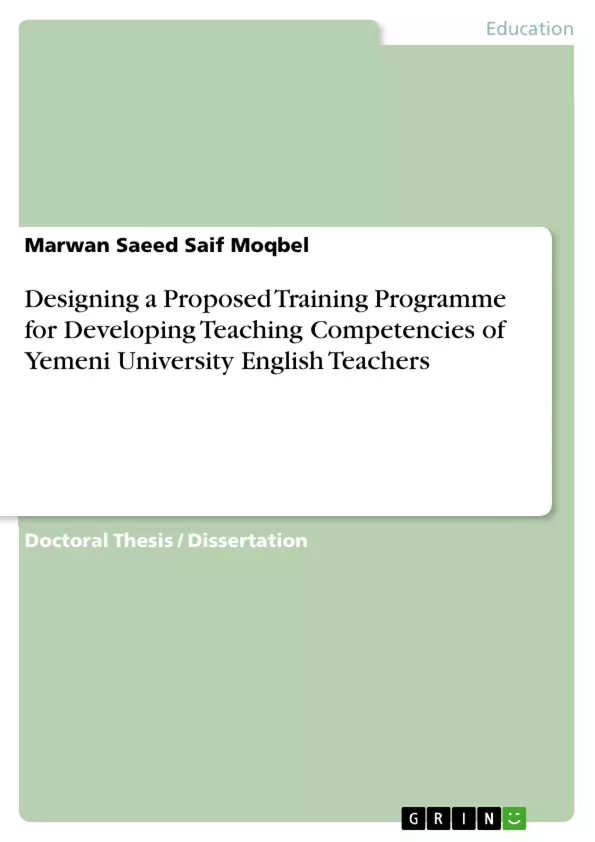The main objective of this study is to investigate the teaching competencies of Yemeni university English teachers in terms of identifying the degree of practicing these competencies from the perspective of the teachers themselves, their students of English departments, and the chairmen of English departments with a view to designing a proposed training programme which aims at developing the teaching competencies of Yemeni university English teachers.
The study primarily adopted the descriptive design and the quantitative approach. The data were collected through a questionnaire which consisted of (73) teaching competencies distributed among five main domains: planning teaching; implementing teaching; using technology; human relations; and assessment, evaluation, and giving feedback. After making sure of its validity and reliability, it was administered to three Yemeni public universities (Sana’a University, Aden University, and Taiz University). The sample consisted of (49) Yemeni university English teachers, (590) students of level four, and (6) chairmen of English departments. The data collected were computed and analyzed using the Statistical Package of Social Sciences (SPSS) for Windows (version 17.0).
The study revealed that the degree of practicing Yemeni university English teachers for the teaching competencies is low. It also revealed that there were statistically significant differences in the means of practicing the teaching competencies by Yemeni university English teachers according to the variable of sample type (university English teachers, students, and chairmen of English departments) at the (0.05) level of significance. These significant differences were found in the means of the target sample responses between teachers and students on the one hand and between students and chairmen on the other hand. However, no statistically significant differences were found in the means of responses between teachers and chairmen or according to the variable of geography. Based on the study results, which highlighted the need of Yemeni university English teachers for training in teaching, a training programme was proposed. Besides, some recommendations to be considered to improve the teaching and learning process in the English departments of Yemeni universities and suggestions for further research were given.
Inhaltsverzeichnis (Table of Contents)
- Introduction
- Literature Review
- The Concept of Teaching Competencies
- Teacher Training and Development
- Needs Assessment in Teacher Training
- Training Needs in Yemeni University English Departments
- Methodology
- Research Design
- Sample and Population
- Data Collection Tools and Procedures
- Data Analysis
- Results and Discussion
- Training Needs of Yemeni University English Teachers
- The Proposed Training Programme
- Conclusion and Recommendations
Zielsetzung und Themenschwerpunkte (Objectives and Key Themes)
The main objective of this doctoral thesis is to design a proposed training program for developing the teaching competencies of Yemeni University English teachers. The study aims to identify the specific training needs of these teachers and then propose a comprehensive and practical training program to address these needs.
- Teaching Competencies and their Development
- Teacher Training and Development in the Context of Yemeni Universities
- Needs Assessment and its Role in Teacher Training
- The Design and Implementation of Effective Training Programs
- The Impact of Training on Teacher Performance and Student Outcomes
Zusammenfassung der Kapitel (Chapter Summaries)
- Introduction: This chapter provides a brief overview of the study, outlining its background, significance, and research questions. It also discusses the context of English language teaching in Yemeni universities and the need for effective teacher training.
- Literature Review: This chapter presents a comprehensive review of the relevant literature on teaching competencies, teacher training, needs assessment, and training needs in Yemeni University English departments. It examines various theoretical frameworks and empirical studies to provide a foundation for the study's methodology and analysis.
- Methodology: This chapter details the research design, sample and population, data collection tools and procedures, and data analysis techniques used in the study. It describes how the research was conducted to ensure its validity and reliability.
- Results and Discussion: This chapter presents the findings of the study, focusing on the identified training needs of Yemeni University English teachers. It also discusses the development of the proposed training program, drawing connections between the identified needs and the program's design features.
Schlüsselwörter (Keywords)
This study focuses on key terms and concepts related to teacher training and development, specifically in the context of English language teaching at Yemeni universities. Some key areas of focus include: teaching competencies, needs assessment, training program design, teacher development, and the impact of training on student learning outcomes. These terms are essential to understanding the research's core objective: to develop a training program tailored to the specific needs of Yemeni English teachers.
- Quote paper
- Marwan Saeed Saif Moqbel (Author), 2015, Designing a Proposed Training Programme for Developing Teaching Competencies of Yemeni University English Teachers, Munich, GRIN Verlag, https://www.grin.com/document/1346138



